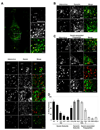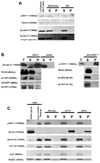Adenovirus transport via direct interaction of cytoplasmic dynein with the viral capsid hexon subunit
- PMID: 20006841
- PMCID: PMC2810746
- DOI: 10.1016/j.chom.2009.11.006
Adenovirus transport via direct interaction of cytoplasmic dynein with the viral capsid hexon subunit
Abstract
Early in infection, adenovirus travels to the nucleus as a naked capsid using the microtubule motor cytoplasmic dynein. How the dynein complex is recruited to viral cargo remains unclear. We find that cytoplasmic dynein and its associated proteins dynactin and NudE/NudEL, but not LIS1 or ZW10, colocalized with incoming, postendosomal adenovirus particles. However, in contrast to physiological cargos, dynein binding to adenovirus was independent of these dynein-associated proteins. Dynein itself directly interacted through its intermediate and light intermediate chains with the adenovirus capsid subunit hexon in a pH-dependent manner. Expression of hexon or injection of anti-hexon antibody inhibited virus transport but not physiological dynein function. These results identify hexon as a direct receptor for cytoplasmic dynein and demonstrate that hexon recruits dynein for transport to the nucleus by a mechanism distinct from that for physiological dynein cargo.
Figures









Similar articles
-
Conformational changes in the adenovirus hexon subunit responsible for regulating cytoplasmic dynein recruitment.J Virol. 2015 Jan 15;89(2):1013-23. doi: 10.1128/JVI.02889-14. Epub 2014 Oct 29. J Virol. 2015. PMID: 25355895 Free PMC article.
-
Circovirus transport proceeds via direct interaction of the cytoplasmic dynein IC1 subunit with the viral capsid protein.J Virol. 2015 Mar;89(5):2777-91. doi: 10.1128/JVI.03117-14. Epub 2014 Dec 24. J Virol. 2015. PMID: 25540360 Free PMC article.
-
Role of cytoplasmic dynein and kinesins in adenovirus transport.FEBS Lett. 2020 Jun;594(12):1838-1847. doi: 10.1002/1873-3468.13777. Epub 2020 Apr 13. FEBS Lett. 2020. PMID: 32215924 Review.
-
Adenovirus recruits dynein by an evolutionary novel mechanism involving direct binding to pH-primed hexon.Viruses. 2011 Aug;3(8):1417-31. doi: 10.3390/v3081417. Epub 2011 Aug 12. Viruses. 2011. PMID: 21994788 Free PMC article. Review.
-
HIV-1 Engages a Dynein-Dynactin-BICD2 Complex for Infection and Transport to the Nucleus.J Virol. 2018 Sep 26;92(20):e00358-18. doi: 10.1128/JVI.00358-18. Print 2018 Oct 15. J Virol. 2018. PMID: 30068656 Free PMC article.
Cited by
-
HIV-1 capsids bind and exploit the kinesin-1 adaptor FEZ1 for inward movement to the nucleus.Nat Commun. 2015 Mar 30;6:6660. doi: 10.1038/ncomms7660. Nat Commun. 2015. PMID: 25818806 Free PMC article.
-
The herpesvirus VP1/2 protein is an effector of dynein-mediated capsid transport and neuroinvasion.Cell Host Microbe. 2013 Feb 13;13(2):193-203. doi: 10.1016/j.chom.2013.01.009. Cell Host Microbe. 2013. PMID: 23414759 Free PMC article.
-
The Intracellular Domain of the Coxsackievirus and Adenovirus Receptor Differentially Influences Adenovirus Entry.J Virol. 2015 Sep;89(18):9417-26. doi: 10.1128/JVI.01488-15. Epub 2015 Jul 1. J Virol. 2015. PMID: 26136571 Free PMC article.
-
Dual-Color Herpesvirus Capsids Discriminate Inoculum from Progeny and Reveal Axonal Transport Dynamics.J Virol. 2016 Oct 14;90(21):9997-10006. doi: 10.1128/JVI.01122-16. Print 2016 Nov 1. J Virol. 2016. PMID: 27581973 Free PMC article.
-
Cytoplasmic trafficking, endosomal escape, and perinuclear accumulation of adeno-associated virus type 2 particles are facilitated by microtubule network.J Virol. 2012 Oct;86(19):10462-73. doi: 10.1128/JVI.00935-12. Epub 2012 Jul 18. J Virol. 2012. PMID: 22811523 Free PMC article.
References
-
- Cotten M, Weber JM. The adenovirus protease is required for virus entry into host cells. Virology. 1995;213:494–502. - PubMed
-
- Dignam JD, Martin PL, Shastry BS, Roeder RG. Eukaryotic gene transcription with purified components. Methods Enzymol. 1983;101:582–598. - PubMed
-
- Dohner K, Nagel CH, Sodeik B. Viral stop-and-go along microtubules: taking a ride with dynein and kinesins. Trends Microbiol. 2005;13:320–327. - PubMed
Publication types
MeSH terms
Substances
Grants and funding
LinkOut - more resources
Full Text Sources
Other Literature Sources
Molecular Biology Databases
Miscellaneous

